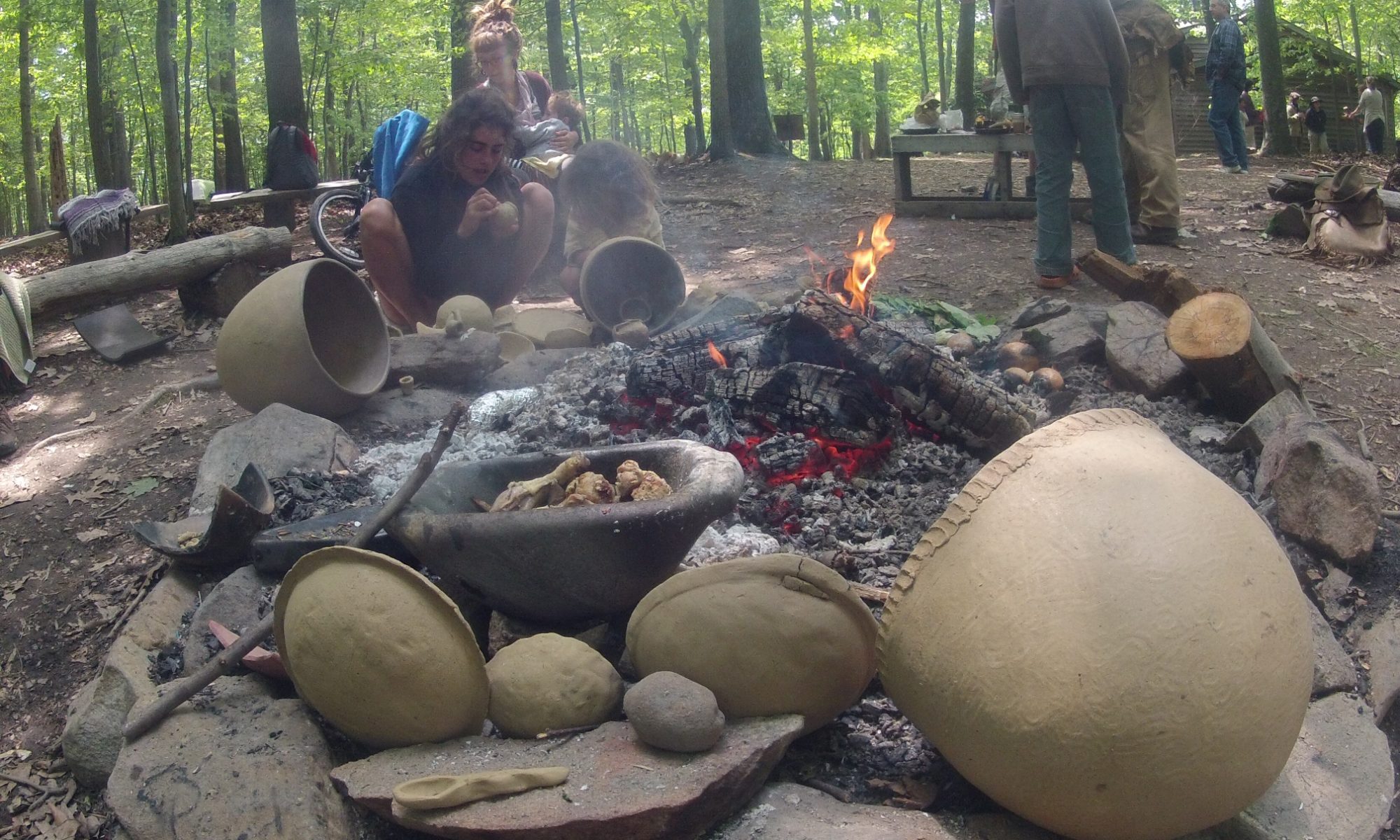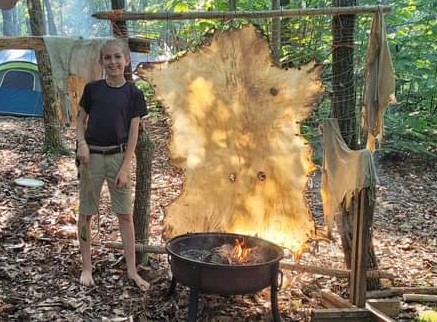- Have you ever wondered “how did the natives make such beautiful and soft leather without all the chemicals?” We will attempt to explain the process so you can try it at home. We are assuming that you already posses the animals skin.
1. Fleshing- with a rib bone, leg bone or hardwood stick that has been carved and burnished, push all the flesh off of the hide. you need a smooth beam (log). You can either lean it against a tree pinning the hide with the beam or lay it across the log pinning it with your body.
2. Dehair– this can be done on or off the rack.
- Off the rack – Soak the hide in a stream till the hair starts to slip on the neck then use the same technique as fleshing.
-
- On the rack- Poke holes every 4 inches around the edge of the hide. Make sure the holes are 1/2 inch in from the edge running parallel to the edge about 1/2 in length. Stretch the hide tight enough using string through the holes and pulling the hide evenly so that is can dry out on the rack without any wrinkles.
-
- once dry use a bone or stone scraper to remove the hair. which leads into the next step
3. Scrape or remove the grain – when the hair is gone you will see a peppery look to the hide. This is hair follicles embedded in the epidermis (outer) layer of the skin. This layer must be removed.
Scrape carefully till the dermis layer is exposed. The skill will become fluffy like suede. It is best to work in small sections or blocks 4 to 6 inches square.
On your first hide you will probably scrape so lightly that this will take hours or scrape so hard that you poke holes through it. Either way, don’t give up, it’s all part of the learning process. you can always tan another hide, right.
Be careful along the belly and inner thigh areas. They tend to be the thinnest and easiest to bust through.
4. Membrane- once the dermis layer is reached turn the hide over and scrape the flesh side till it is fluffy as well. This side doesn’t take as much scraping. In both steps 3 and 4 work the center of the hide first and then do the edges. I like to keep a two-inch buffer around holes and the edges, then come back and scrape those areas last.
5. Brain- take the animal brain(if you have it) and smash it up in warm water. about 1/2 gallon to 1 gallon is all you need. If you don’t have any brains you can substitute with egg yolks (not the whites). DON’T USE HOT WATER.
Soak your hide in the solution either by taking the hide off the rack and placing it in a container with the solution or use something to apply the solution saturating the hide while it is racked.
6. Softening- once the hide is saturated and let sit overnight without drying out, you can begin to soften the hide. the fibers in the dermis layer must be kept moving until the hide is completely dry. Do this by re racking the hide ( if not still on the rack) and using a stick with a rounded smooth end.
Take the smooth end of the stick and push on the hide while sliding the stick across the surface of the hide. When the hide is no longer cool to the touch then it should be dry. You can soften off the rack as well but it doesn’t turn out as flat and smooth as one softened on a rack.
You should have a milky white soft and fluffy skin in your hands. be careful not to get it wet or it will turn back into rawhide.
7. Smoking- First make the hides into a bag by either sewing or gluing the edges together, Leave an opening about 6 inches around in the neck area. While sewing or gluing the bag together, have a hardwood fire lit and burning.
Dig a hole about 6 -8 inches across and 1 foot deep. Hang the hide bag upside down over the hole. Connect a skirt made of cloth or other hides to the neck.
Add hot coals only, no burning sticks to the hole. Break up the punky wood and cover the coals
Stake or use rocks to hold the skirt down around the hole to funnel smoke into the bag. Make sure that the punky wood does not flame up. Add punky wood as needed to keep a heavy smoke generated.
Once the outside of the bags starts to change color (about 1 hour) turn the hide inside out and repeat. The longer you smoke the hide on each side the darker the color will be. 2 hours on each side turns out a nice dark color.
Once the second side is complete you can wash the hide and let it dry and you will have a beautiful piece of buckskin. This process can be completed in just a couple of days.
We hope this post was helpful. If you are a beginner seeking hands-on experience in hide tanning or other skills, please check out our Adult Workshops


